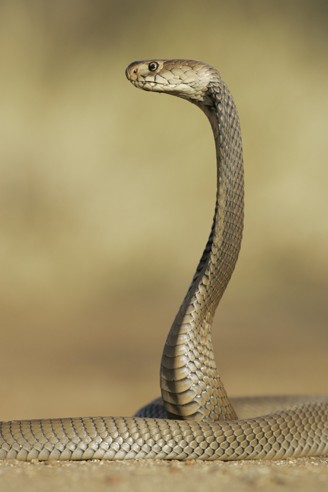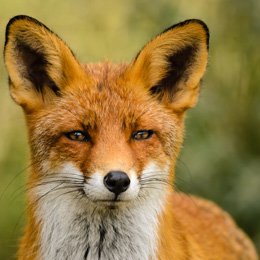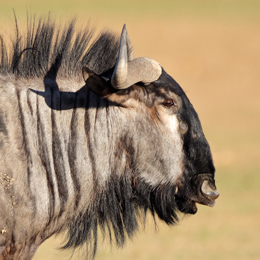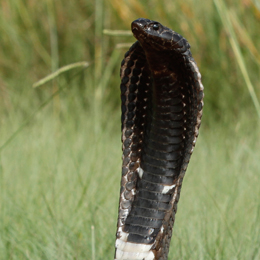What are Spitting Cobras?
Spitting cobras are any species of venomous snakes that can project venom from their fangs, hence the name ‘spitting cobras’. This unique ability to project venom with a precise aim is a defensive mechanism found in most cobra species, specifically of the Genus Naja and few others. Such species of cobras that are recognized for possessing a set of spitting fangs use specialized muscles that contract the venom gland forcing the venom out through the fangs.

Naja mossambica spitting venom as defense
?
Image credits: Stuart G Porter/Shutterstock
So far there are 14, out of the 28, species of the Genus Naja that have been recognized with the spitting ability and a few other snakes like the rinkhals of the Elapidae family that also showcase the same spitting behavior. However, the rinkhals is classified under a different genus Hemachatus and due to the major differences between genus Hemachatus and Naja, we will only focus on the 14 Naja spitting cobra species in this article. Spitting cobras are dominant in the Naja genus, further characterized by two distinct types according to their location – the Asian and African spitting cobras.
African Spitting Cobra- Naja ashei
- Naja katiensis
- Naja mossambica
- Naja nigricincta
- Naja nigricollis
- Naja nubiae
- Naja pallida
Asian Spitting Cobra- Naja mandalayensis
- Naja miolepis
- Naja philippinensis
- Naja samarensis
- Naja siamensis
- Naja sputatrix
- Naja sumatrana
Basic Anatomy
The basic anatomy of spitting cobras is similar to any other cobra with slight variations in terms of the body scales, coloration and size. Almost all the species of the spitting cobra (Asian & African) showcase a medium to large sized body. The largest species i.e. Ashe’s spitting cobra and the smallest i.e. the Mozambique spitting cobra illustrate the size of spitting cobras which is on an average 2.8 – 8 ft in length. The average weight of spitting cobras is around 7 – 9 kg depending upon the species. Almost all spitting cobras possess a flattened head which is generally broad and distinct from the neck with a rounded snout and large nostrils like the Philippine spitting cobra.
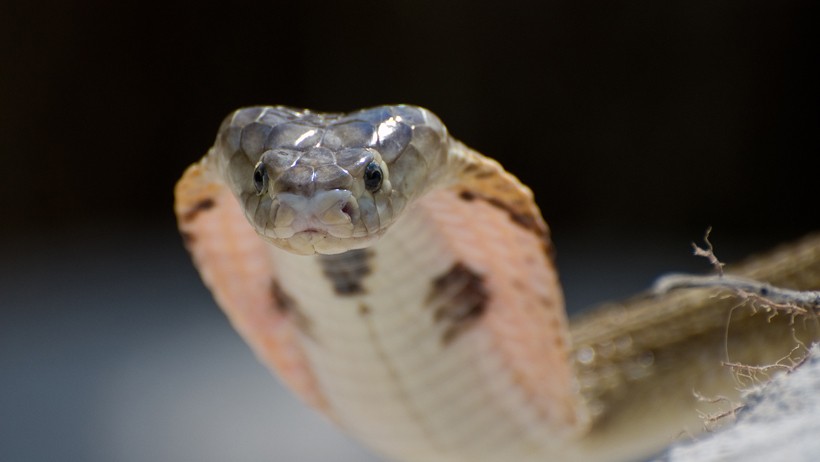
Almost all spitting cobras possess a flattened head with a rounded snout and large nostrils
?
Image credits: Heiko Kiera/Shutterstock
The head can be elliptical or depressed like in the case of the Equatorial and the Mandalay spitting cobra. While few show distinct hood marks like the Javan spitting cobra there are others that don’t show any mark like the Equatorial spitting cobra. However, many African spitting cobras portray dark cross bands located around the neck like the Nubian spitting cobra. They do possess an inflatable neck hood which is the flap of the skin located behind the head of the cobra. When spitting cobras feel threatened they can expand their movable ribs by drawing in air from its lungs, a defense mechanism often used to frighten or warn predators.
Fangs & Venom Ejection
Spitting cobras are renowned for their ability to spit venom with absolute accuracy that can cause irritation in the iris and even permanent blindness. Their fangs are located in the top jaw right at the front of the mouth. It has been theorized by scientists that the species developed this adaptation as a primary defense mechanism to evade being trampled by antelopes. Spitting cobras tend to aim for the eyes while spitting out venom that is ejected in distinctive geometric patterns. Once the muscles squeeze the venom glands, the venom pushes through forward-facing holes present at the tip of the fangs. While some spitting cobras change their position or lunge forward while spitting venom, few others follow the movements of their intruder.
The fact that they can spit so accurately is because of their unique ability to predict the next motion of its predator. A spitting cobra can launch its lethal venom at a distance of 6 – 8 ft, a self-defense mechanism that takes place very fast. Their venom is often a combination of neurotoxins and cytotoxins that can easily cause paralysis, corneal swelling and permanent blindness. Each species of the spitting cobras delivers a different venom yield in each jet spray which is enough to wound their predators. Generally, spitting cobras don’t spit venom while seeking prey and instead resort to ambush their prey with a quick strike.
Reproduction
Depending upon a variety of factors, for example climatic conditions, geographical distribution and presence of abandoned burrows, spitting cobras can reproduce just like any other cobra in the Naja genus. They are oviparous which means that they lay eggs either inside burrows or create a nest made from fallen debris and vegetative scraps. Spitting cobras briefly meet during the mating season and during the mating ritual the male tries to dominate its partner by pushing down the female using its hood. The breeding season can take place any time of the year depending upon the particular species. The common period during which mating takes place is either at start of the dry season or early winters like in the case of the Black necked spitting cobra that breeds between September and December. In unusual cases like the Red spitting cobra, the breeding season takes place in April. Asian spitting cobras generally mate during the dry season which is means in the months of August to October. The incubation period of a typical female spitting cobra lasts for 70 – 90 days on average. During such period the female spitting cobra is highly aggressive, territorial and protective.
Average Clutch Size:- Naja pallida: 6 - 21 eggs
- Naja katiensis: 8 - 25 eggs
- Naja nigricollis: 10 - 15 eggs
- Naja ashei, Naja philippinensis & Naja sumatrana: 10 - 20 eggs
- Naja mossambica & Naja nigricincta: 10 - 22 eggs
- Naja sputatrix: 13 - 16 eggs
- Naja samarensis & Naja siamensis: 13 - 19 eggs
- Naja mandalayensis: 13 - 20 eggs
Behavior
Spitting cobras exhibit similar behavioral adaptations with very few differences that set them apart. They are terrestrial reptiles that are fast, alert and usually spit venom when they feel threatened. In general, the spitting ability of the species is triggered by sudden movement or continuous motion of an object. Adult spitting cobras hide mostly in burrows, termite holes, old logs, bushes and other vegetative cover. This is a form of camouflage that allows them to ambush their prey during a hunt. There are studies concluding that spitting cobras may show cannibalism as in the case of the Red spitting cobra. Most spitting cobras tend to be aggressive during the night like the Indo-Chinese spitting cobra and they usually avoid confrontation during the day.
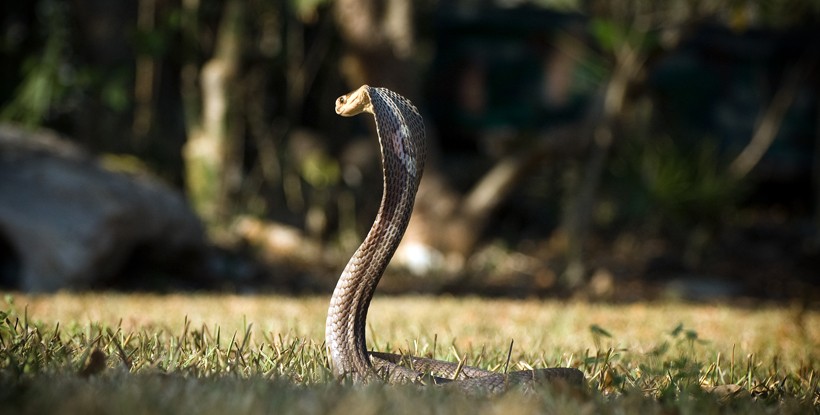
Spitting cobras showcase defense mechanisms like their upright postures followed by a threatening hood.
?
Image credits: Heiko Kiera/Shutterstock
One of the most interesting behavioral adaptations of spitting cobras is their intimidating demeanor. Spitting cobras showcase defense mechanisms like their upright postures followed by a threatening hood. This display of raising the upper part of the body while spreading out the neck ribs (hooding) is meant for the purpose of scaring or warding off predators. This also includes hissing while standing as tall as one-third of the total body length, a stunning spectacle. The ability to spray venom several yards is different for each species. However, all spitting cobras usually aim for the oppressor’s eyes. The species perform a fast undulating head movement which helps in distributing venom in an oval shaped geometric pattern.
Spitting cobras often showcase their defensive behavior against oppressors like mongoose, predatory birds like eagles and giant monitor lizards. While most species are nocturnal hunters, there are a few that are diurnal like the Equatorial spitting cobra. Being opportunistic hunters, they generally feed on small mammals, lizards, carrion, eggs, frogs etc., slithering in the wilderness waiting for the right moment. Their potent venom, which is primarily cytotoxic with postsynaptic neurotoxic effects, can easily paralyze or even making oppressors blind. Since they have a slow metabolism rate, they can survive for longer periods without food.
African Spitting Cobra – Physiology, Habitat & Diet
- Ashe's spitting cobra (Naja ashei)
The Ashe’s spitting cobra is the world’s largest spitting cobra found in Africa and is also commonly referred to as the ‘giant spitting cobra’. The average length of this species varies between 1.5 – 2.2 m (4.9 – 7.2 ft) although the largest specimen caught till date in Kenya measured 2.7 m (8.9 ft) in length. This spitting cobra is heavily built and showcases various coloring patterns right from pale mustard to dark brown. The species might show slight speckles or blotches on its upper body with a dark brown throat. It consists of 17 – 25 mid-body scale rows, 51 – 69 subcaudal scale rows and 176 – 219 ventral scale rows.
The species is distributed in northeastern and eastern Africa occupying the dry lowlands of eastern and northern Kenya, southern Ethiopia and northeastern Uganda. This species is an aggressive snake that takes shelter in animal burrows and piles of vegetative debris. The large brown spitting cobra that has been named after James Ashe, founder of the Bio-Ken snake farm located in Watamu along the Kenyan coast.
The species is a large sized cobra that hunts small mammals, birds and several reports witnessed the species swallowing a two-foot monitor lizard and a five-foot puff adder.
- Mali cobra (Naja katiensis)
This species, commonly known as the Mali cobra, is a moderately sized snake that reaches an average length of 0.4 – 1 m (1.6 – 3.3 ft). Found exclusively in western Africa, the species prefers a semi-dessert habitat and is also a terrestrial occupant of the Savannah grasslands. The geographical distribution of the snake is dominant in Nigeria, Cameroon, Ivory Coast, Mali, Ghana, Burkina Faso, Guinea, southern Mauritius and Senegal. This species consists of a reddish brown, maroon body and a light brown belly that is aligned with 23 – 27 midbody dorsal scale rows. The venom of the Katian spitting cobra is neurotoxic and the cobra often spits 2 jets of venom directly towards the intruder’s eyes. The naja katiensis is a fast-moving snake that preys on rodents, amphibians and other smaller snakes.
The Ashe’s spitting cobra is the world’s largest spitting cobra found in Africa and is also commonly referred to as the ‘giant spitting cobra’. The average length of this species varies between 1.5 – 2.2 m (4.9 – 7.2 ft) although the largest specimen caught till date in Kenya measured 2.7 m (8.9 ft) in length. This spitting cobra is heavily built and showcases various coloring patterns right from pale mustard to dark brown. The species might show slight speckles or blotches on its upper body with a dark brown throat. It consists of 17 – 25 mid-body scale rows, 51 – 69 subcaudal scale rows and 176 – 219 ventral scale rows.
The species is distributed in northeastern and eastern Africa occupying the dry lowlands of eastern and northern Kenya, southern Ethiopia and northeastern Uganda. This species is an aggressive snake that takes shelter in animal burrows and piles of vegetative debris. The large brown spitting cobra that has been named after James Ashe, founder of the Bio-Ken snake farm located in Watamu along the Kenyan coast.
The species is a large sized cobra that hunts small mammals, birds and several reports witnessed the species swallowing a two-foot monitor lizard and a five-foot puff adder.
This species, commonly known as the Mali cobra, is a moderately sized snake that reaches an average length of 0.4 – 1 m (1.6 – 3.3 ft). Found exclusively in western Africa, the species prefers a semi-dessert habitat and is also a terrestrial occupant of the Savannah grasslands. The geographical distribution of the snake is dominant in Nigeria, Cameroon, Ivory Coast, Mali, Ghana, Burkina Faso, Guinea, southern Mauritius and Senegal. This species consists of a reddish brown, maroon body and a light brown belly that is aligned with 23 – 27 midbody dorsal scale rows. The venom of the Katian spitting cobra is neurotoxic and the cobra often spits 2 jets of venom directly towards the intruder’s eyes. The naja katiensis is a fast-moving snake that preys on rodents, amphibians and other smaller snakes.
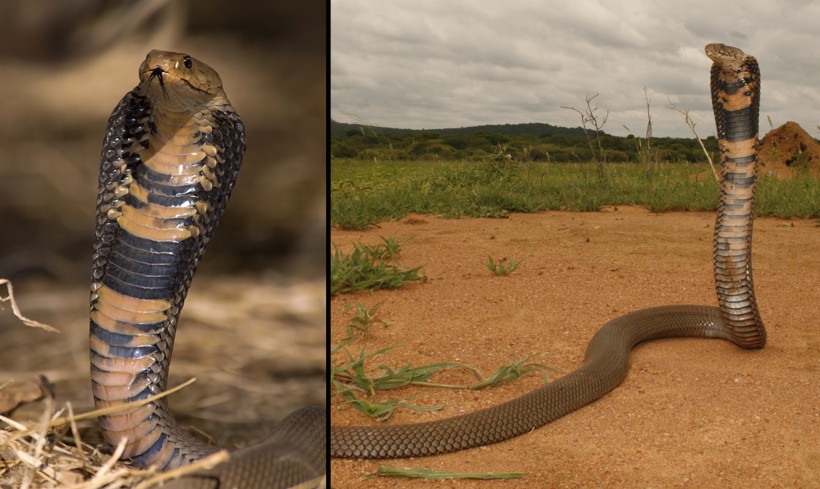
Mozambique spitting cobra
?
Image credits: Left: Albie Venter/Shutterstock, Right: Andre Coetzer/Shutterstock
- Mozambique spitting cobra (Naja mossambica)
The Mozambique spitting cobra is mostly found in open woodlands, savannah grasslands and rocky hillsides of southern Angola, Mozambique, Zimbabwe, Namibia and northern Botswana. Its population is limited to southeastern Africa where the average size of an adult male cobra is 0.9 m (2.9 ft) in length. The color of this species is pale gray to olive brown/black with a salmon-pink belly. It consists of a smooth underbelly with dorsal scales edged in black that are aligned in 23 – 25 mid body rows. This small to medium sized cobra inhabits burrows near water bodies and is a nocturnal hunter. Its venom is mainly cytotoxic that can cause massive tissue damage to its prey like small rodents, birds and other snakes, especially the Puff adder.
- Zebra spitting cobra & Black spitting cobra (Naja nigricincta)
This particular species of African spitting cobra consists of two subspecies: the Zebra spitting cobra (N.n.nigricincta) and the Black spitting cobra (N.n.woodi). The Zebra spitting cobra is located in southern Angola, South Africa and central and northern Namibia. The coloration of this subspecies is gray-brown, yellow or pink and consists of dark cross bars that run from the head to its tail. The stripes are evenly spaced although they can either be fragmented or complete. The Black spitting cobra maintains a solid black or gray coloring with a black hood. The subspecies is found in a semi-desert habitat of southern Africa. Both subspecies show an average length of 1 – 1.5 m (4 – 5 ft) and feed on small mammals, snakes, and amphibians. They spit venom towards its prey causing temporary paralysis.
The Mozambique spitting cobra is mostly found in open woodlands, savannah grasslands and rocky hillsides of southern Angola, Mozambique, Zimbabwe, Namibia and northern Botswana. Its population is limited to southeastern Africa where the average size of an adult male cobra is 0.9 m (2.9 ft) in length. The color of this species is pale gray to olive brown/black with a salmon-pink belly. It consists of a smooth underbelly with dorsal scales edged in black that are aligned in 23 – 25 mid body rows. This small to medium sized cobra inhabits burrows near water bodies and is a nocturnal hunter. Its venom is mainly cytotoxic that can cause massive tissue damage to its prey like small rodents, birds and other snakes, especially the Puff adder.
This particular species of African spitting cobra consists of two subspecies: the Zebra spitting cobra (N.n.nigricincta) and the Black spitting cobra (N.n.woodi). The Zebra spitting cobra is located in southern Angola, South Africa and central and northern Namibia. The coloration of this subspecies is gray-brown, yellow or pink and consists of dark cross bars that run from the head to its tail. The stripes are evenly spaced although they can either be fragmented or complete. The Black spitting cobra maintains a solid black or gray coloring with a black hood. The subspecies is found in a semi-desert habitat of southern Africa. Both subspecies show an average length of 1 – 1.5 m (4 – 5 ft) and feed on small mammals, snakes, and amphibians. They spit venom towards its prey causing temporary paralysis.
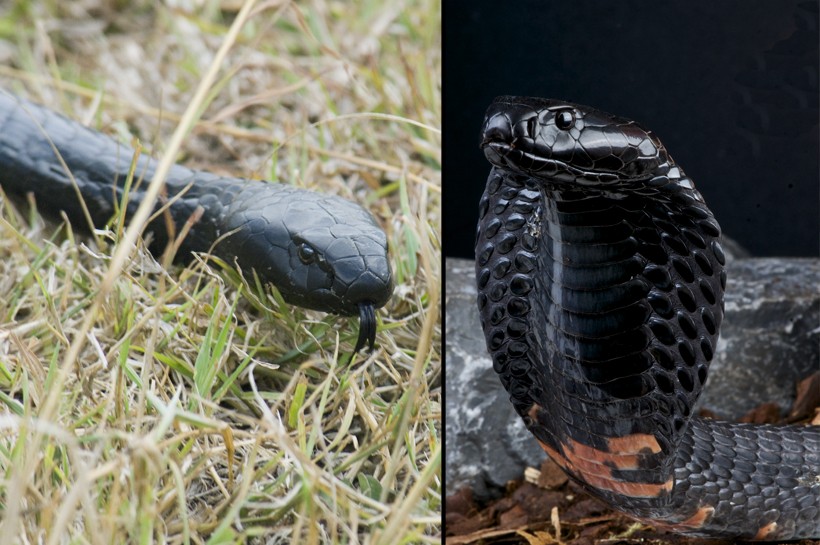
Black-necked spitting cobra
?
Image credits: Left: Jeannette Katzir Photog/Shutterstock, Right: reptiles4all/Shutterstock
- Black-necked spitting cobra (Naja nigricollis)
This particular species that is also known as the Black-necked spitting cobra is found mostly in sub-Saharan Africa. Due to morphological and regional differences, the species is entirely distinct from Naja nigricincta. Preferring semi-desert conditions the species inhabits savannah strips as well as tropical and sub-tropical regions across countries like Angola, Chad, Nigeria, Liberia, Kenya, Central African Republic, Gabon and Ghana. The snake has a medium sized body with an average length of 1.3 – 2 m (4 – 7 ft) showing different color variants depending upon its habitat. Some specimens are pale gray or black with a reddish orange or yellow ventral side and a broad black neck. The neck is often marked with a pinkish bar, a distinguishing factor for the species. Other specimens can maintain a yellowish brown or copper coloration but their necks often don’t possess similar markings. There are 182 – 196 ventral scales, 54 – 66 sub-caudal scales and 21 – 23 mid body dorsal scales. This species primarily feeds on small rodents and can spit venom that can cause permanent blindness or irritation.
- Nubian spitting cobra ( Naja nubiae)
Also known as the Nubian spitting cobra, this species possesses a slender posture showing a total length of 1.5 m (4.9 ft) that is found primarily in north-eastern Africa. Its distribution is prominent in Egypt, Chad, Sudan, Niger and Eritrea. The species consists of a brownish-gray body with two broad bands, dark in color that marks the nape. It consists of 51 – 59 paired subcaudal scales, 214 – 228 ventral scales and 25 scale rows that run mid body along the dorsal surface. With a relatively broad and flattened head, this slender sized snake with its rounded snout expands its ribs to form a hood when it feels threatened. The Naja pallida, that possesses a single dark band around the neck, differs from Naja nubiae in the sense that the latter showcases a pair of dark throat spots and double bands spread across the neck.
This particular species that is also known as the Black-necked spitting cobra is found mostly in sub-Saharan Africa. Due to morphological and regional differences, the species is entirely distinct from Naja nigricincta. Preferring semi-desert conditions the species inhabits savannah strips as well as tropical and sub-tropical regions across countries like Angola, Chad, Nigeria, Liberia, Kenya, Central African Republic, Gabon and Ghana. The snake has a medium sized body with an average length of 1.3 – 2 m (4 – 7 ft) showing different color variants depending upon its habitat. Some specimens are pale gray or black with a reddish orange or yellow ventral side and a broad black neck. The neck is often marked with a pinkish bar, a distinguishing factor for the species. Other specimens can maintain a yellowish brown or copper coloration but their necks often don’t possess similar markings. There are 182 – 196 ventral scales, 54 – 66 sub-caudal scales and 21 – 23 mid body dorsal scales. This species primarily feeds on small rodents and can spit venom that can cause permanent blindness or irritation.
Also known as the Nubian spitting cobra, this species possesses a slender posture showing a total length of 1.5 m (4.9 ft) that is found primarily in north-eastern Africa. Its distribution is prominent in Egypt, Chad, Sudan, Niger and Eritrea. The species consists of a brownish-gray body with two broad bands, dark in color that marks the nape. It consists of 51 – 59 paired subcaudal scales, 214 – 228 ventral scales and 25 scale rows that run mid body along the dorsal surface. With a relatively broad and flattened head, this slender sized snake with its rounded snout expands its ribs to form a hood when it feels threatened. The Naja pallida, that possesses a single dark band around the neck, differs from Naja nubiae in the sense that the latter showcases a pair of dark throat spots and double bands spread across the neck.
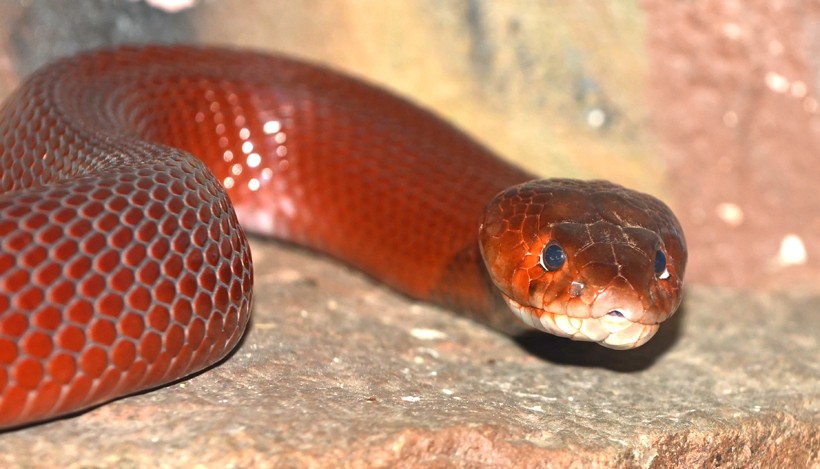
Red spitting cobra
?
Image credits: mountainpix/Shutterstock
- Red spitting cobra ( Naja pallida)
This Red spitting cobra is a small to medium-sized snake that maintains an average length of 0.7 – 1.2 m (2.3 – 4 ft) although it may grow to a maximum length of 1.5 m (4.9 ft). It is an attractive species of the cobra family that is easily distinguishable because of its bright salmon red coloring. The species consists of a broad black throat band and unique tear drop markings spread across its body. With smooth dorsal scales aligned in 21 – 27 mid body rows, this species can show a color variation ranging from bright red or orange to pinkish red, brown and gray. The species can be found in northeastern and eastern Africa occupying dense woodlands and dry savannah grasslands. Adult cobras are nocturnal hunters found primarily in southern Kenya, Ethiopia, southern Egypt, northern Sudan, Eritrea and northern Tanzania. If threatened the species spits two jets of venom at its oppressor which is mainly cytotoxic, although the venom can also affect the nervous system if the venom yield is high.
This Red spitting cobra is a small to medium-sized snake that maintains an average length of 0.7 – 1.2 m (2.3 – 4 ft) although it may grow to a maximum length of 1.5 m (4.9 ft). It is an attractive species of the cobra family that is easily distinguishable because of its bright salmon red coloring. The species consists of a broad black throat band and unique tear drop markings spread across its body. With smooth dorsal scales aligned in 21 – 27 mid body rows, this species can show a color variation ranging from bright red or orange to pinkish red, brown and gray. The species can be found in northeastern and eastern Africa occupying dense woodlands and dry savannah grasslands. Adult cobras are nocturnal hunters found primarily in southern Kenya, Ethiopia, southern Egypt, northern Sudan, Eritrea and northern Tanzania. If threatened the species spits two jets of venom at its oppressor which is mainly cytotoxic, although the venom can also affect the nervous system if the venom yield is high.
Asian Spitting Cobra – Physiology, Habitat & Diet
- Mandalay spitting cobra (Naja mandalayensis)
The Mandalay spitting cobra or the Burmese cobra is an Asian species possessing a fairly large body measuring around 1 – 1.2 m (3.3 – 3.9 ft) in length. The yellowish-brown body is normally lined with dark speckles and a dark chin and throat. The species also maintains 2-3 bands spread across venter of the hood. Found primarily in the dry regions of Burma its distribution extends through Mandalay, Magway and Sagaing districts. This Asian spitting cobra is a nocturnal hunter that feeds on small rodents, birds and amphibians and therefore prefers a habitat with stunted savannah growth and acacia plantations. This species has no specific markings except for a spectacle shaped hood mark that may be present in juveniles. Not much is known about this species and its venom except that it showcases neurotoxic effects and contains slight cytotoxic elements.
- Palawan spitting cobra (Naja miolepis)
Known as the Palawan spitting cobra, this cobra is an endemic species in the Philippines that can grow to an average length of 1.2 – 1.4 m (3.9 – 4.5 ft). The snake consists of a slender body with 184 ventral scales showcasing a darkened coloring all over. The neck of the species is light brown/cream colored and its body is layered with conspicuous light cross bands that run across its dorsal surface. It also consists of a chevron V-shaped mark on its hood which has become a distinguishing feature for this species. The naja miolepis was formally classified as a subspecies of Naja naja but reclassified after careful study as one of the spitting cobras found in Asia.
- Philippine spitting cobra (Naja philippinensis)
The Philippine spitting cobra is a stocky, heavily built snake that is highly venomous and native to the northern parts of the Philippines. It is a medium sized snake with an average length of 1 – 1.2 m (3.3 – 3.9 ft) with uniform light brown to medium brown coloring. The species consists of 182 – 193 ventral scales, 36 – 49 sub-caudal scales and 23 – 27 dorsal scale rows. They are found primarily on the islands of Azria, Luzon, Catanduanes, Masbate and Mindoro. They prefer forested regions along with thick grasslands, agricultural fields and low lying plains found close to large puddles of water. The venom of this species is neurotoxic which it uses to prey upon small rodents, frogs, birds and sizeable birds.
The Mandalay spitting cobra or the Burmese cobra is an Asian species possessing a fairly large body measuring around 1 – 1.2 m (3.3 – 3.9 ft) in length. The yellowish-brown body is normally lined with dark speckles and a dark chin and throat. The species also maintains 2-3 bands spread across venter of the hood. Found primarily in the dry regions of Burma its distribution extends through Mandalay, Magway and Sagaing districts. This Asian spitting cobra is a nocturnal hunter that feeds on small rodents, birds and amphibians and therefore prefers a habitat with stunted savannah growth and acacia plantations. This species has no specific markings except for a spectacle shaped hood mark that may be present in juveniles. Not much is known about this species and its venom except that it showcases neurotoxic effects and contains slight cytotoxic elements.
Known as the Palawan spitting cobra, this cobra is an endemic species in the Philippines that can grow to an average length of 1.2 – 1.4 m (3.9 – 4.5 ft). The snake consists of a slender body with 184 ventral scales showcasing a darkened coloring all over. The neck of the species is light brown/cream colored and its body is layered with conspicuous light cross bands that run across its dorsal surface. It also consists of a chevron V-shaped mark on its hood which has become a distinguishing feature for this species. The naja miolepis was formally classified as a subspecies of Naja naja but reclassified after careful study as one of the spitting cobras found in Asia.
The Philippine spitting cobra is a stocky, heavily built snake that is highly venomous and native to the northern parts of the Philippines. It is a medium sized snake with an average length of 1 – 1.2 m (3.3 – 3.9 ft) with uniform light brown to medium brown coloring. The species consists of 182 – 193 ventral scales, 36 – 49 sub-caudal scales and 23 – 27 dorsal scale rows. They are found primarily on the islands of Azria, Luzon, Catanduanes, Masbate and Mindoro. They prefer forested regions along with thick grasslands, agricultural fields and low lying plains found close to large puddles of water. The venom of this species is neurotoxic which it uses to prey upon small rodents, frogs, birds and sizeable birds.
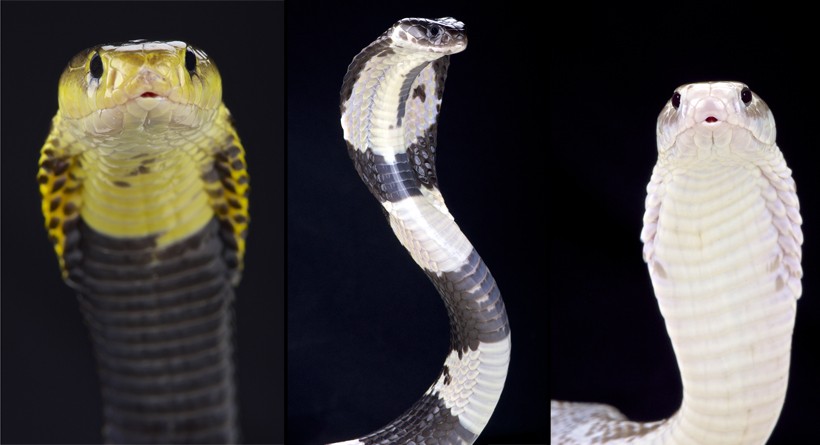
Left to right: Samar spitting cobra, Indo-Chinese spitting cobra, Javan spitting cobra
?
Image credits: All 3 images: reptiles4all/Shutterstock
- Samar spitting cobra (Naja samarensis)
The Samar spitting cobra also known as Peter’s cobra is a native species of the southern Philippines. It is a highly venomous snake that is specifically found on the islands of Mindanao and Visayas in a habitat that consists of mountainous jungles and tropical plains. The cobra shows an average length of 1.4 m (4.5 ft) showcasing a sharp coloration that varies from black and yellow to deep green. The snake showcases 161 – 184 ventral scales, 41 – 52 sub-caudal scales, 17 – 19 dorsal scales running mid body and 17 – 25 scale rows that persist around the hood. The species also preys upon rodents, frogs and other smaller reptiles.
- Indo-Chinese spitting cobra (Naja siamensis)
The Indo-Chinese spitting cobra is an attractive species found in Southeast Asia that is known for its striking coloration and highly venomous fangs. Also referred to as the Thai spitting cobra, it is a medium sized snake with a rather thick body that normally grows up to 0.9 – 1.2 m (3 – 3.9 ft) in length. However a maximum length of 5 ft has been observed once. The body color varies from deep gray or black to brown and has distinguishing white stripes that run through its dorsal surface. They prefer a hilly terrain or lowlands found primarily in the woodlands of Thailand, Laos, Burma, Cambodia and Vietnam. It is a nocturnal species that has a variable temperament showcasing an aggressive behavior only at night.
- Javan spitting cobra (Naja sputatrix)
The Javan spitting cobra, also referred to as the Indonesian spitting cobra, is a thick, stout snake that has a medium sized body. It grows to an average length of 1.3 m (4.3 ft) but can attain a maximum size of 6.1 ft. It showcases an evenly placed symmetry, large nostrils and a rounded snout. Javan adults might consist of yellowish brown or black coloring with darkened blotches that are non-uniform. They mostly possess a chevron shaped mark on their hoods and at juveniles you can observe throat bands and lateral throat spots. This species prefers dry woodlands, deciduous monsoon forests and dry savannah grasslands. Its geographical distribution is on the islands of Java, Lombok, Komodo, Sumbawa, Lesser Sunda Islands of Bali, Flores and Alor. Quite recently a specimen was found on the Rinca Island on December 26, 2015.
The Samar spitting cobra also known as Peter’s cobra is a native species of the southern Philippines. It is a highly venomous snake that is specifically found on the islands of Mindanao and Visayas in a habitat that consists of mountainous jungles and tropical plains. The cobra shows an average length of 1.4 m (4.5 ft) showcasing a sharp coloration that varies from black and yellow to deep green. The snake showcases 161 – 184 ventral scales, 41 – 52 sub-caudal scales, 17 – 19 dorsal scales running mid body and 17 – 25 scale rows that persist around the hood. The species also preys upon rodents, frogs and other smaller reptiles.
The Indo-Chinese spitting cobra is an attractive species found in Southeast Asia that is known for its striking coloration and highly venomous fangs. Also referred to as the Thai spitting cobra, it is a medium sized snake with a rather thick body that normally grows up to 0.9 – 1.2 m (3 – 3.9 ft) in length. However a maximum length of 5 ft has been observed once. The body color varies from deep gray or black to brown and has distinguishing white stripes that run through its dorsal surface. They prefer a hilly terrain or lowlands found primarily in the woodlands of Thailand, Laos, Burma, Cambodia and Vietnam. It is a nocturnal species that has a variable temperament showcasing an aggressive behavior only at night.
The Javan spitting cobra, also referred to as the Indonesian spitting cobra, is a thick, stout snake that has a medium sized body. It grows to an average length of 1.3 m (4.3 ft) but can attain a maximum size of 6.1 ft. It showcases an evenly placed symmetry, large nostrils and a rounded snout. Javan adults might consist of yellowish brown or black coloring with darkened blotches that are non-uniform. They mostly possess a chevron shaped mark on their hoods and at juveniles you can observe throat bands and lateral throat spots. This species prefers dry woodlands, deciduous monsoon forests and dry savannah grasslands. Its geographical distribution is on the islands of Java, Lombok, Komodo, Sumbawa, Lesser Sunda Islands of Bali, Flores and Alor. Quite recently a specimen was found on the Rinca Island on December 26, 2015.
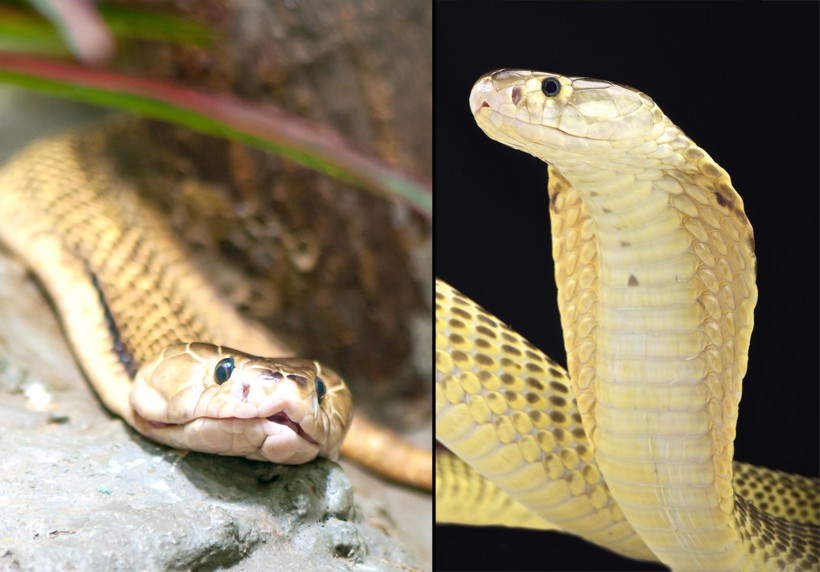
Sumatra spitting cobra
?
Image credits: Left: Kagai19927/Shutterstock, Right: reptiles4all/Shutterstock
- Sumatra spitting cobra (Naja sumatrana)
The Equatorial spitting cobra, also known as the Sumatra spitting cobra or the Malayan spitting cobra, is a medium sized cobra that measures 0.9 – 1.2 m (3 – 3.9 ft) in length. This south Asian species showcases smooth dorsal scales, around 15 – 19 mid body scale rows, 40 – 57 sub-caudal scales and 179 – 201 ventral scales alongside and 19 – 27 rows of scales around its hood. There are two color types of the Equatorial spitting cobra – a yellow colored form that is found in Thailand and a deep black colored form found in Malaysia, Indonesia, Philippines and Singapore. This species doesn’t showcase any hood marks. This stocky built species prefers a habitat of tropical rainforests or dense jungle thickets. The species is diurnal and highly terrestrial feeding primarily on frogs and rodents.
The Equatorial spitting cobra, also known as the Sumatra spitting cobra or the Malayan spitting cobra, is a medium sized cobra that measures 0.9 – 1.2 m (3 – 3.9 ft) in length. This south Asian species showcases smooth dorsal scales, around 15 – 19 mid body scale rows, 40 – 57 sub-caudal scales and 179 – 201 ventral scales alongside and 19 – 27 rows of scales around its hood. There are two color types of the Equatorial spitting cobra – a yellow colored form that is found in Thailand and a deep black colored form found in Malaysia, Indonesia, Philippines and Singapore. This species doesn’t showcase any hood marks. This stocky built species prefers a habitat of tropical rainforests or dense jungle thickets. The species is diurnal and highly terrestrial feeding primarily on frogs and rodents.
IUCN Status
Spitting cobras in Asia and Africa face many dangers, being most of them a result of severe human interference. The most serious threats that the species face are habitat destruction and illegal trade, especially in Southeast Asia. According to the IUCN Red List, most of the spitting cobras have been designated as Vulnerable, Near Threatened or are of Least Concern. However, there are few that haven’t been listed but still face localized threats like in the case of the Nubian spitting cobra which is considered as ‘Near Threatened’ in Egypt. The Mozambique and the Zebra spitting cobra have not been evaluated by the IUCN yet. The Katian or Mali spitting cobra is considered a species of ‘Least Concern’. The Red spitting cobra has not received any designation on the IUCN Red List since its population is still abundant.
In Asia is the Indo-Chinese spitting cobra the most endangered cobra species and listed as ‘Vulnerable’ recently on the IUCN Red List. The reason is that the species faces a high risk of becoming extinct due to a rapid decline in population. The species is heavily harvested in Vietnam for its meat by local restaurants. It is also being exploited for its skin and use in traditional medicine. The Mandalay spitting cobra is another species that is being exploited for commercial trade and therefore also indicated as ‘Vulnerable’ on the Red List. While both the Samar and Equatorial spitting cobra are considered as ‘Least Concern’, the Philippines spitting cobra is already ‘Near Threatened’ according to the IUCN.
Funfacts
- Ashe’s spitting cobra is closely related to the Mozambique spitting cobra in terms of certain morphological and behavioral characteristics.
- The fangs of the Mozambique are modified with channel openings at the tip and directed forward at right angles for spitting venom.
- Despite preferring open grasslands, thick woodlands and agricultural fields, spitting cobras are often encountered near human settlements in Southeast Asia.
- The smallest species of spitting cobras is the Mozambique while the largest being the Ashe’s spitting cobra.
- The most potent venom is that of the Philippine spitting cobra, one of the world’s most dangerous true cobras whose venom is completely composed of neurotoxins.
- The holes present within the fangs of spitting cobras are tear dropped shaped to ensure spraying of a narrow stream of venom.
- Spitting cobras are capable of spraying venom consecutively 40 times in a very short time span.
